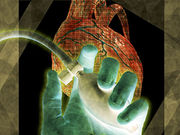In five-year follow-up study CMR is stronger predictor of major adverse cardiovascular events
FRIDAY, May 13, 2016 (HealthDay News) — Cardiovascular magnetic resonance (CMR) is a stronger predictor of risk for major adverse cardiovascular events (MACEs) than single-photon emission computed tomography (SPECT), according to a study published online May 10 in the Annals of Internal Medicine.
John P. Greenwood, M.B., Ch.B., Ph.D., from the University of Leeds in the United Kingdom, and colleagues established the ability of CMR and SPECT to predict MACEs in annual follow-up of the Clinical Evaluation of Magnetic Resonance Imaging in Coronary Heart Disease (CE-MARC) study for a minimum of five years. Complete follow-up was seen for 99 percent of the 752 recruited patients.
The researchers found that 16.6 percent of the 628 patients who underwent CMR, SPECT, and the reference standard test of X-ray angiography had at least one MACE. Abnormal findings on CMR and SPECT were strong and independent predictors of MACE (hazard ratio, 2.77 and 1.62, respectively; P < 0.001 and P = 0.014, respectively). After adjustment for other cardiovascular risk factors, angiography result, or stratification for initial patient treatment, only CMR remained a significant predictor.
“Five-year follow-up of the CE-MARC study indicates that compared with SPECT, CMR is a stronger predictor of risk for MACEs, independent of cardiovascular risk factors, angiography result, or initial patient treatment,” the authors write. “This further supports the role of CMR as an alternative to SPECT for the diagnosis and management of patients with suspected coronary heart disease.”
Full Text (subscription or payment may be required)
Editorial (subscription or payment may be required)
Copyright © 2016 HealthDay. All rights reserved.








